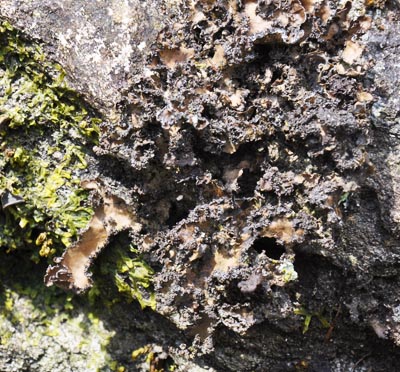Pseudocyphellaria lacerata
This species was described new to science in 1941 by Degelius from material collected in the Azores (see Galloway (1994)). It closely resembles P. intricata, and is a substantial foliose lichen with, when moist, a brown thallus that becomes grey-brown on drying out. Its surface is smooth, though it may develop ridges. Instead of the purple grey coloured eruptions of soralia along the lobe margins of the thallus of P. intricata this species develops marginal simple or branched cylindrical coral-like isidia that occasionally extend onto the thallus surface. It might be mistaken for a Nephroma or a Peltigera. The underside gives it away in that the Pseudocyphellaria is covered in a dense, dark brown stubble of rhizines. A careful search amongst the rhizines will also reveal the presence of small sunken bald patches, the pseudocyphellae that give it its generic name and the English name of the Americans-the speckle bellies. Peltigera has large bushy, rather widely spaced rhizines and Nephroma a bare undersurface. Similar Sticta species smell distinctly of fish when moist.
 |
 Sm.jpg) |
| Photos: Liz Fleming-Williams | |
PLEASE NOTE. All Pseudocyphellarias appear to be exceptionally rare in Wales and you must not just rip up bits to look at the underside!! In dry weather take a small sprayer and water with you to moisten the thallus before carefully turning it over in situe. An illuminated hand lens is almost a must.
P. norvegica differs in having a C+ red and KC+ orange medulla and is sorediate. Its lobes are somewhat more rounded and ridged than the superficially similar P. intricata and there are more soralia scattered over the thallus surface. Unfortunately occasionally P. intricata soredia can grow in situe to develop a cortex and so resemble isidia and there is indeed doubt cast by some (eg Ahti et al (eds.) (2007) that any British material is this species. If in doubt seek expert help.
Note also that P. lacerata is protected by Schedule 8 of the Wildlife & Countryside Act and a licence must be obtained before any material can be collected.
- Read more about Pseudocyphellaria lacerata
- Log in to post comments
